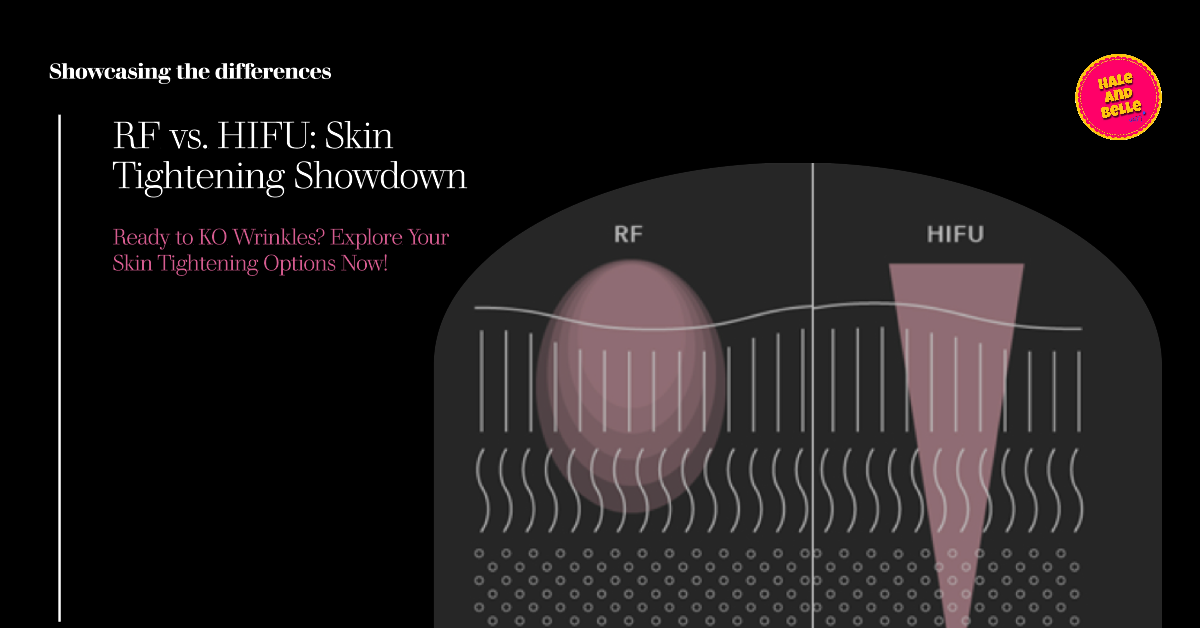In the realm of medical treatment, particularly in the context of non-invasive procedures, the battleground often revolves around targeting different depths within the body. This battle is epitomized by two prominent skin tightening techniques: Radiofrequency (RF) and High-Intensity Focused Ultrasound (HIFU), each offering distinct approaches to address various medical conditions. Now, let’s delve into the disparities between these two treatments.
In This Article
RF vs. HIFU: Surface Buff vs. Deep Lift
In the war against wrinkles and sagging skin, RF (radiofrequency) and HIFU (high-intensity focused ultrasound) are two powerful weapons, but they target different territories. Radiofrequency (RF) refines the surface, while High-Intensity Focused Ultrasound (HIFU) reaches the core.
RF: Ironing Out Wrinkles from the Outside
RF technology utilizes radio waves to gently heat the upper layers of your skin. This stimulates collagen production, a protein that plumps and firms the skin. Think of it like ironing out wrinkles from the outside. Since RF works superficially, it’s ideal for addressing concerns like fine lines, uneven texture, and mild laxity. Multiple sessions are typically recommended to achieve optimal results, with a gradual improvement in skin tone and tightness.
Benefits of RF Therapy
- Improved skin texture and tone
- Reduction in fine lines and wrinkles
- Enhanced skin firmness and elasticity
- Non-invasive with minimal downtime
- Safe for all skin types
HIFU: Sculpting from Within for Lifted Results
HIFU, on the other hand, goes deeper. It employs focused ultrasound energy to target specific layers within the skin and underlying tissues. This targeted heating creates controlled micro-injuries, which trigger the body’s natural healing response, leading to increased collagen production and skin tightening. Imagine HIFU as a sculptor working from within, reshaping and lifting the foundational structures of your skin. Due to its deeper penetration, HIFU can address more profound concerns like deeper wrinkles, jowls, and sagging in areas like the cheeks and jawline. While HIFU has the potential to deliver noticeable results in fewer sessions, a consultation with a qualified professional is crucial to determine the best course of treatment.
Benefits of HIFU Treatment
- Noticeable improvement in skin laxity and firmness
- Long-lasting results with minimal to no downtime
- Non-invasive and safe procedure
- Precise targeting of deeper tissue layers
- Suitable for various areas of the face and body
Radio Waves vs. Sonic Boom: How they Work Their Magic
Gentle Nudges vs. Strategic Bombs: How They Generate Heat
RF and HIFU may be on opposite sides of the battlefield, but they both utilize heat to wage war against wrinkles. However, the way they generate and deliver that heat is vastly different.
RF: Bulk Heating for Overall Rejuvenation
RF technology employs radio waves, a form of electromagnetic energy. When applied to the skin, these waves cause a gentle, bulk heating effect in the upper layers. This controlled thermal stimulation triggers the production of collagen and elastin, the building blocks of youthful, firm skin. It’s like a gentle nudge for your body to ramp up its natural anti-aging processes. As a result, RF is particularly effective in stimulating overall skin rejuvenation, improving texture, and tackling fine lines.
HIFU: Focused Ultrasound for Deep Targeted Injury
HIFU, on the other hand, brings out the big guns. It uses high-intensity focused ultrasound energy. Imagine magnifying sunlight with a magnifying glass to create a hot spot – that’s essentially what HIFU does. This concentrated energy bypasses the surface layers and delivers precise thermal injury to targeted points deep within the skin and underlying tissues, particularly the SMAS (Superficial Musculoaponeurotic System), a layer crucial for facial structure. This controlled damage triggers the body’s healing response, leading to a surge in collagen production and tightening of the targeted areas. HIFU acts like a strategic bomb, delivering targeted heat to specific zones for a more dramatic lifting and skin tightening effect.
Slow & Steady vs. One-Hit Wonder
The desire for a youthful appearance has fueled the development of various technologies. Two popular options in this arena are radiofrequency (RF) and high-intensity focused ultrasound (HIFU). While both aim to tighten skin and reduce wrinkles, they differ in their approach and results.
Gradual Improvement with RF Therapy
RF therapy utilizes radio waves to heat the deeper layers of the skin, stimulating collagen production. This collagen boost leads to a gradual improvement in skin texture and firmness. However, multiple RF sessions are typically required, spaced over weeks or months, for noticeable results. The benefit lies in its cumulative effect and minimal downtime.
Potential for Single-Session Results with HIFU
HIFU, on the other hand, employs focused ultrasound energy to target specific depths within the skin. This targeted heating creates micro-injuries, triggering the body’s natural healing response and subsequent collagen production. HIFU boasts the potential for significant results in a single session. However, downtime can be present, and multiple sessions might be needed for optimal or long-lasting effects.
Choosing the Right Approach
Choosing between RF and HIFU depends on your desired outcome and tolerance for treatment. If you prefer a gradual approach with minimal downtime, RF might be ideal. For those seeking potentially dramatic results faster, HIFU could be an option. Consulting a dermatologist can help determine the most suitable treatment based on your individual needs and expectations.
Who’s Your Skin Tightening BFF? | Choose the Right Approach
In the fight against wrinkles, neither RF nor HIFU is a clear victor. The best choice depends on your specific needs and desired outcome. Let’s explore when each approach reigns supreme:
When RF Reigns Supreme
- Subtle Concerns:For addressing fine lines, uneven texture, and mild laxity, RF’s gentle approach is ideal. It progressively tightens and smoothes the skin’s surface for a natural, youthful glow.
- Comfort First:RF treatments are generally considered more comfortable due to the lower intensity compared to HIFU. If you have a lower tolerance for discomfort, RF might be a better option.
- Gradual Improvement:If you prefer a more gradual change that allows your skin to adapt, the incremental approach of RF can be a good fit.
When HIFU Takes the Crown
- Deeper Concerns:HIFU is the clear champion for tackling deeper wrinkles, jowls, and sagging, particularly in areas like the cheeks and jawline. Its targeted heating reaches deeper layers to achieve a more dramatic lifting effect.
- Faster Results:If you’re looking for quicker results, HIFU has the potential to deliver noticeable improvement in a single session.
- Structural Concerns:For those with concerns about facial structure and definition, HIFU’s ability to target the SMAS layer can provide a more sculpted and lifted appearance.
Ultimately, the best way to declare your victor is to consult a qualified professional. They can assess your individual needs and recommend the most appropriate approach, whether it’s RF’s gradual skin tightening or HIFU’s targeted lift.
Downtime: Knockout or Quick Jab? | Side Effects and Considerations
As with any battle, there are factors to consider beyond the initial clash. Let’s explore the final bell, focusing on side effects and recovery expectations for both RF and HIFU.
Safety and Comfort Comparisons
Both RF and HIFU are generally safe when performed by a qualified professional. However, RF is typically considered the more comfortable option due to the lower intensity of the treatment. RF may cause mild redness or swelling that subsides quickly. HIFU, on the other hand, can cause temporary discomfort or tingling during the procedure, and some individuals may experience slight redness, swelling, or bruising that usually resolves within a few days.
Downtime and Recovery Expectations
Downtime is another key consideration. RF typically requires minimal to no downtime, allowing you to resume your daily activities immediately after the session. HIFU may also involve minimal downtime, but some individuals might experience temporary tenderness or swelling that requires a day or two of recovery.
Ultimately, the best treatment for you depends on your tolerance for discomfort and recovery time.
Takeaway:
Both RF and HIFU offer valuable weapons in the fight against wrinkles. By understanding their strengths, weaknesses, and recovery considerations, you can choose the approach that best suits your needs and emerge victorious with smoother, tighter skin.
Was this information helpful?
Poll Results
Yes: 0
No: 0











